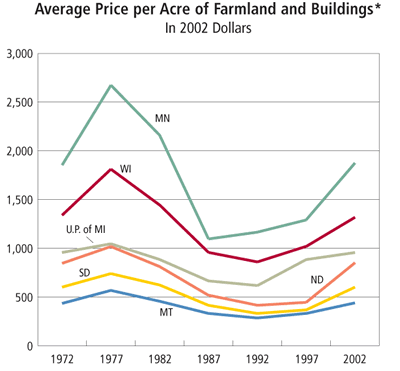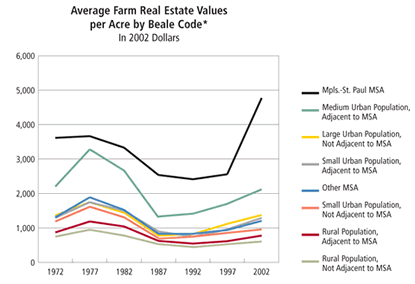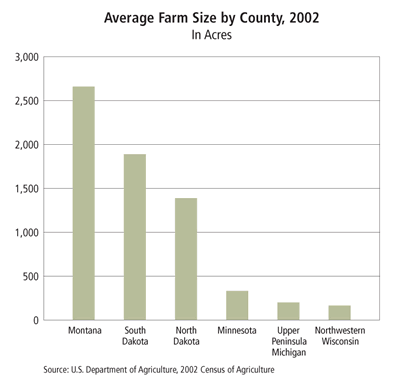Despite drought, depressed agricultural commodity prices, higher costs and changes in international trade, district farm real estate values have increased steadily since the early 1990s. Strong harvests and generous levels of government payments have helped to boost values.
 However, not all of the increase during the 1990s was the result of agricultural conditions or factors. In fact, in several parts of the district, agricultural conditions have likely had less influence than other factors. Alternative uses for crop and grazing land, such as development near urban centers, hunting and other outdoor activities, and hobby ranches have boosted farm real estate values in a number of areas. Nevertheless, growth in values spread throughout many parts of the district (see map).
However, not all of the increase during the 1990s was the result of agricultural conditions or factors. In fact, in several parts of the district, agricultural conditions have likely had less influence than other factors. Alternative uses for crop and grazing land, such as development near urban centers, hunting and other outdoor activities, and hobby ranches have boosted farm real estate values in a number of areas. Nevertheless, growth in values spread throughout many parts of the district (see map).
Population density helps boost farmland values
The price for farm real estate is said to capitalize the future earnings in the price of the land. Therefore, expectations for high crop and livestock prices relative to input costs, generous levels of government payments and strong harvests boost land values. However, expectations for depressed farm prices or output levels, or increased input costs, such as higher gas prices or borrowing costs, often have the reverse effect.

*County average weighted by total farmland.
Source: U.S. Department of Agriculture
Future agricultural productivity isn't the only factor that affects land values. Alternative uses for farmland increase demand and impact selling prices. Housing developments near urban areas, hunting land, transportation—all represent alternative uses. These factors have helped boost the price of land, and many of them occur near urban areas.
A consistent finding in a number of economic studies is that proximity to an urban area has a notable impact on farmland prices. As urban areas expand, the value of nearby farmland grows with an increased number of alternative uses. These gains in prices are revealed when county average farm real estate values are compared by population density. The U.S. Department of Agriculture's Beale codes designate a number, 1 to 9, to a county based on population density and proximity to urban areas. A lower number represents a more densely populated county; a higher number represents a less densely populated county.
During the 1990s, the largest increase in district farm real estate values was recorded in the most densely populated counties, particularly those counties in the Minneapolis-St. Paul metropolitan statistical area. Farmland values in counties in other district MSAs, such as Sioux Falls, S.D., Fargo, N.D., and Billings, Mont., grew more slowly than values in the Minneapolis-St. Paul MSA. Counties not classified as MSAs were more likely to have higher values if they were adjacent to MSAs than counties with similar populations not adjacent to MSAs (see chart).

* A designation based on population and proximity to urban areas.
Source: U.S. Department of Agriculture
Geographically, the strongest gains in farmland values during the 1990s were recorded by counties in northwestern Wisconsin, where 10 of the 20 counties with the fastest growing values were located. Several of these counties are in proximity to Minneapolis-St. Paul. Meanwhile, counties with the largest decreases were located in sparsely populated areas of North Dakota, where 17 of the 20 fastest decliners were located.
Natural amenities impact prices
Farmland near recreational areas and beautiful vistas can increase in price as nonfarming buyers choose to locate near mountains, trees and waterways. The land purchased may not always be the most productive agriculturally, but it provides a buyer a chance to live in a more serene and picturesque area or a developer to build a group of homes in a unique setting.
Therefore, it's not surprising that during the 1990s, the counties in Montana that showed the strongest gains in farm real estate values were in the mountainous western part of the state, including Silver Bow, Sanders and Granite. In Minnesota's lake resort country in the north-central part of the state, values increased 130 percent in Cass County during the 1990s, the 12th fastest county increase in the district. In timber-rich northwestern Wisconsin and Upper Peninsula of Michigan, a number of counties with lakes and some that border Lake Superior showed strong growth, although several of these counties have relatively small amounts of farmland. In all of these cases, when natural amenities drive prices, it's more difficult for the farmers in the area to expand operations or for new farmers to enter.
Putting it all together
If the factors that affect farm real estate values are taken together, including agricultural and nonagricultural factors, what impact do they have? A number of economists have investigated various factors associated with changes in land values. Productivity, market conditions, proximity to urban areas and alternative uses play a considerable role.
District county data show the association between farm real estate values and farm income, farm size, population density and the presence of timberland, water, hills and mountains. According to data analysis, farm income at the county level is associated with increases in per acre farm real estate values, albeit to a relatively small degree. Counties with larger farms tend to have smaller per acre values. While the presence of mountains in a county is associated with higher farmland values, the presence of small hills is associated with lower values. In addition, a higher concentration of timber is correlated with higher values, while the presence of water is ambiguous.
After controlling for farm income, farm size and the presence of natural amenities, higher population density as defined by Beale codes was associated with higher real estate values. Counties in the Minneapolis-St. Paul MSA had values about 90 percent higher than the district's most sparsely populated counties. Meanwhile, counties in other district MSAs had values about 20 percent higher than the most sparsely populated counties. Notable differences were observed between states, as values in Minnesota, Wisconsin and the Upper Peninsula of Michigan were about 45 percent to 55 percent higher than values in North Dakota, Montana and South Dakota.

Values reach for 1977 levelsWhile farm real estate values increased during the 1990s, they are still shy of prices in 1977. District farm real estate values, which include the estimated market value of farmland and buildings, peaked in 1977, when adjusted for inflation, during a time of relatively solid agricultural conditions. The U.S. Department of Agriculture estimates the market value of farm real estate every five years based on the Census of Agriculture (see chart). However, net farm income, also adjusted for inflation, began to tail off during the 1970s and into the farm crisis years of the 1980s. At the same time, average farmland values decreased, reaching bottom in most district states by 1992. Net farm income leveled off during the 1990s as farm real estate values climbed, but remained below 1977 levels. As farm income and real estate values declined, the total amount of district land in cropland and pastureland decreased 3.4 percent between 1969 and 2002. Throughout this period, farm real estate values were higher in Minnesota compared with other parts of the district. Values were lower in the wide expanses of Montana and the Dakotas, where farms are typically larger and yield less revenue per acre compared with Minnesota and northwestern Wisconsin. In 2002, Wyoming was the only state with more acres of farmland per capita (68.9) than Montana (65.5), North Dakota (62.0) and South Dakota (57.6). Other district states were below six acres per capita. (See U.S. map.) |






